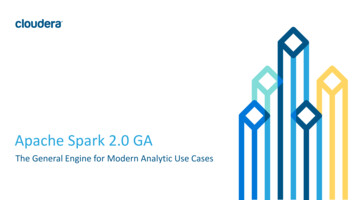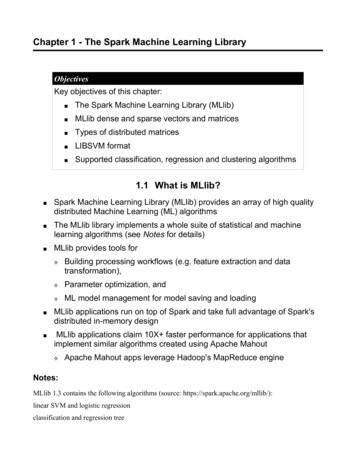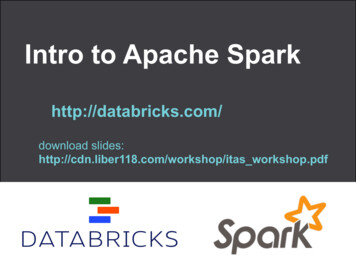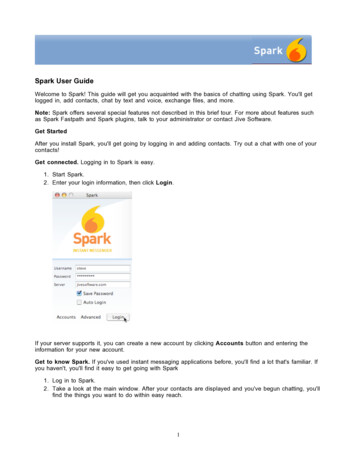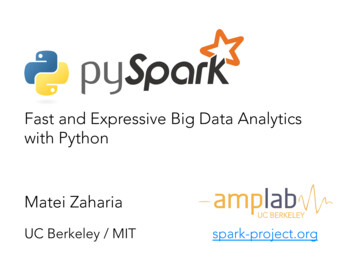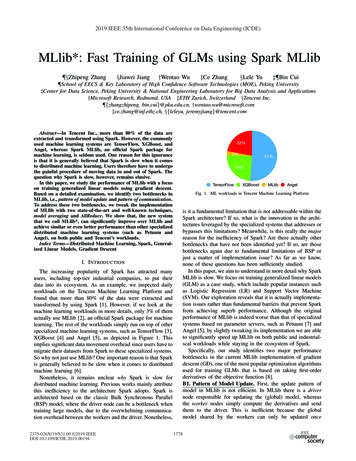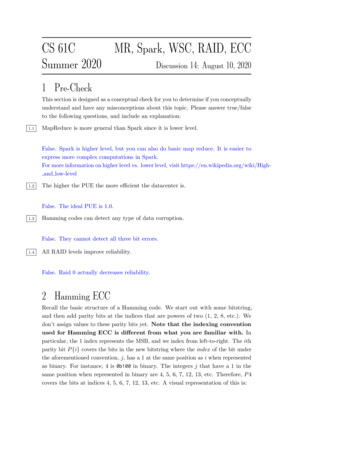
Transcription
CS 61CMR, Spark, WSC, RAID, ECCSummer 20201Discussion 14: August 10, 2020Pre-CheckThis section is designed as a conceptual check for you to determine if you conceptuallyunderstand and have any misconceptions about this topic. Please answer true/falseto the following questions, and include an explanation:1.1MapReduce is more general than Spark since it is lower level.False. Spark is higher level, but you can also do basic map reduce. It is easier toexpress more complex computations in Spark.For more information on higher level vs. lower level, visit https://en.wikipedia.org/wiki/Highand low-level1.2The higher the PUE the more efficient the datacenter is.False. The ideal PUE is 1.0.1.3Hamming codes can detect any type of data corruption.False. They cannot detect all three bit errors.1.4All RAID levels improve reliability.False. Raid 0 actually decreases reliability.2Hamming ECCRecall the basic structure of a Hamming code. We start out with some bitstring,and then add parity bits at the indices that are powers of two (1, 2, 8, etc.). Wedon’t assign values to these parity bits yet. Note that the indexing conventionused for Hamming ECC is different from what you are familiar with. Inparticular, the 1 index represents the MSB, and we index from left-to-right. The ithparity bit P {i} covers the bits in the new bitstring where the index of the bit underthe aforementioned convention, j, has a 1 at the same position as i when representedas binary. For instance, 4 is 0b100 in binary. The integers j that have a 1 in thesame position when represented in binary are 4, 5, 6, 7, 12, 13, etc. Therefore, P 4covers the bits at indices 4, 5, 6, 7, 12, 13, etc. A visual representation of this is:
2MR, Spark, WSC, RAID, ECCSource: https://en.wikipedia.org/wiki/Hamming code2.1How many bits do we need to add to 00112 to allow single error correction?m parity bits can cover bits 1 through 2m 1, of which 2m m 1 are data bits.Thus, to cover 4 data bits, we need 3 parity bits.2.2Which locations in 00112 would parity bits be included?Using P to represent parity bits: PP0P01122.3Which bits does each parity bit cover in 00112 ?Parity bit 1: 1, 3, 5, 7Parity bit 2: 2, 3, 6, 7Parity bit 3: 4, 5, 6, 72.4Write the completed coded representation for 00112 to enable single error correction.Assume that we set the parity bits so that the bits they cover have even parity.100001122.5How can we enable an additional double error detection on top of this?Add an additional parity bit over the entire sequence.2.6Find the original bits given the following SEC Hamming Code: 01101112 . Again,assume that the parity bits are set so that the bits they cover have even parity.Parity group 1: errorParity group 2: okayParity group 4: errorTo find the incorrect bit’s index, we simply sum up the indices of all the erroneousbits.Incorrect bit: 1 4 5, change bit 5 from 1 to 0: 0110011201100112 101122.7Find the original bits given the following SEC Hamming Code: 10010002Parity group 1: errorParity group 2: okayParity group 4: errorIncorrect bit: 1 4 5, change bit 5 from 1 to 0: 1001100210011002 01002
MR, Spark, WSC, RAID, ECC33.13RAIDFill out the following table:RAID 0RAID 1RAID 2RAID 3RAID 4RAID 54ConfigurationPro/Good forCon/Bad forSplit data across multipledisksNo overhead, fast read /writeReliabilityMirrored Disks:copy of dataFast read / write, Fast recoveryHigh overhead expensiveHamming ECC: Bit-levelstriping, one disk per parity groupSmaller overheadRedundant check disksByte-level striping withsingle parity disk.Smallest overheadcheck paritytoNeed to read all disks,even for small reads, todetect errorsBlock-level striping withsingle parity disk.Higher throughput forsmall readsStill slow small writes (Asingle check disk is a bottleneck)Block-level striping, parity distributed acrossdisks.Higher throughput ofsmall writesThe time to repair a diskis so long that anotherdisk might fail in themeantime.ExtraMapReduceFor each problem below, write pseudocode to complete the implementations. Tips: The input to each MapReduce job is given by the signature of map(). emit(key k, value v) outputs the key-value pair (k, v). for var in list can be used to iterate through Iterables or you can callthe hasNext() and next() functions. Usable data types: int, float, String. You may also use lists and customdata types composed of the aforementioned types. intersection(list1, list2) returns a list of the common elements of list1,list2.
44.1MR, Spark, WSC, RAID, ECCGiven a set of coins and each coin’s owner in the form of a list of CoinPairs, computethe number of coins of each denomination that a person has.CoinPair:String personString coinType1map(CoinPair pair):1map(CoinPair pair):emit(pair, 1)4.21reduce( , ):reduce(CoinPair pair, Iterable int count):total 0for num in count:total numemit(pair, total)Using the output of the first MapReduce, compute each person’s amount of money.valueOfCoin(String coinType) returns a float corresponding to the dollar value ofthe coin.map(tuple CoinPair, int output):map(tuple CoinPair, int output):pair, amount outputemit(pair.person,valueOfCoin(pair.coinType) * amount)51reduce( , ):reduce(String person, Iterable float values):total 0for amount in values:total amountemit(person, total)SparkResilient Distributed Datasets (RDD) are the primary abstraction of a distributed collection of itemsTransforms RDD RDDmap(f ) Return a new transformed item formed by calling f on a source element.flatMap(f ) Similar to map, but each input item can be mapped to 0 or moreoutput items (so f should return a sequence rather than a single item).reduceByKey(f ) When called on a dataset of (K, V ) pairs, returns a datasetof (K, V ) pairs where the values for each key are aggregated using thegiven reduce function f , which must be of type (V, V ) V .Actions RDD V aluereduce(f ) Aggregate the elements of the dataset regardless of keys using afunction f .Call sc.parallelize(data) to parallelize a Python collection, data.
MR, Spark, WSC, RAID, ECC5.15Given a set of coins and each coin’s owner, compute the number of coins of eachdenomination that a person has. Then, using the output of the first result, computeeach person’s amount of money. Assume valueOfCoin(coinType) is defined andreturns the dollar value of the coin.The type of coinPairs is a tuple of (person, coinType) pairs.1coinData sc.parallelize(coinPairs)out1 coinData.map(lambda (k1, k2): ((k1, k2), 1)).reduceByKey(lambda v1, v2: v1 v2)out2 out1.map(lambda (k, v): (k[0], v * valueOfCoin(k[1]))).reduceByKey(lambda v1, v2: v1 v2)5.2Given a student’s name and course taken, output their name and total GPA.CourseData:int courseIDfloat studentGrade // a number from 0-4The type of students is a list of (studentName, courseData) pairs.1studentsData sc.parallelize(students)out studentsData.map(lambda (k, v): (k, (v.studentGrade, 1))).reduceByKey(lambda v1, v2: (v1[0] v2[0], v1[1] v2[1])).map(lambda (k, v): (k, v[0] / v[1]))6Warehouse-Scale ComputingSources speculate Google has over 1 million servers. Assume each of the 1 millionservers draw an average of 200W, the PUE is 1.5, and that Google pays an averageof 6 cents per kilowatt-hour for datacenter electricity.6.1Estimate Google’s annual power bill for its datacenters.1.5 · 106 servers · 0.2kW/server · 0.06/kW-hr · 8760 hrs/yr 157.68 M/year6.2Google reduced the PUE of a 50,000-machine datacenter from 1.5 to 1.25 withoutdecreasing the power supplied to the servers. What’s the cost savings per year?building powerPUE TotalIT equipment power Savings (P U Eold P U Enew ) IT equipment power(1.5 1.25) · 50000 servers · 0.2kW/server · 0.06/kW-hr · 8760hrs/yr 1.314 M/year
RAID 3 Byte-level striping with single parity disk. Smallest overhead to check parity Need to read all disks, even for small reads, to detect errors RAID 4 Block-level striping with single parity disk. Higher throughput for small reads Still slow small writes (A single check disk is a bot-tleneck) RAID 5 Block-level striping, par-ity .


